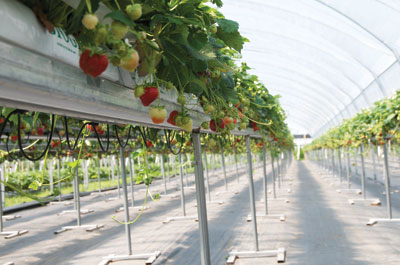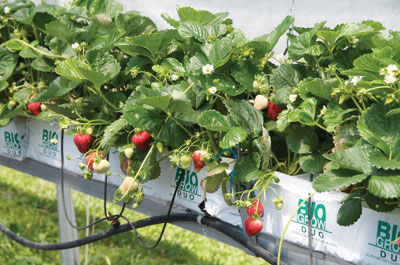
More and more fruit and vegetable farmers across Canada are incorporating the use of high tunnels in their operations.
More and more fruit and vegetable farmers across Canada are incorporating the use of high tunnels in their operations.
 |
|
| There are many benefits offered by high tunnels to growers of market vegetables, berries and fruit trees. PHOTOS COURTESY YVES DESJARDINS, UNIVERSITY OF LAVAL Advertisement
|
High tunnels haven’t changed significantly from the time of their creation around 1949 by Emery Myers Emmert, a pioneering professor of horticulture at the University of Kentucky. They consist of a metal greenhouse-type frame attached to metal posts driven into the ground and covered with greenhouse-grade polyethylene plastic.
The tunnels are ventilated as required on hot days by rolling up the sides and/or ends by hand or by using a hand-crank.
There are many benefits offered by high tunnels to growers of market vegetables, berries and fruit trees. The enclosed space provides elevated temperatures that allow extension of the growing season, and also provides a temperature buffer when the entire season is a chilly one.
SAVINGS SEEN IN BOTH DRIP IRRIGATION AND PESTICIDE USAGE
In some milder areas of Canada, they allow farmers to grow crops three or four seasons of the year, and this translates directly into better profits. However, high tunnels also boost profits through higher quality. Fruit, berries and veggies are protected against wind stress, rain, storms and pests such as fungus and birds that would otherwise degrade them in the fields. High tunnels can also provide savings in both drip irrigation and pesticide usage.
 |
|
| Laval University is among centres involved in high tunnel research.
|
However, “while high tunnels have the potential to accelerate growth of vegetable crops,” notes Doug Waterer, “this does not necessarily result in earlier or higher yields.”
Waterer is a professor in the Department of Plant Sciences at the University of Saskatchewan in Saskatoon who has studied high tunnels extensively. “We have seen problems with overheating that have reduced yields of crops like peppers and lettuce,” he says, “while pollination and fruit rot have been problematic for melons and tomatoes.”
LETTUCE AND BELL PEPPERS IN SASKATCHEWAN STUDY
In one recent study year, Waterer examined the potential of using high tunnels to increase yields and/or quality of romaine lettuce and bell peppers. Performance of plants in the high tunnels was compared to standard production techniques – otherwise similar crop management procedures were used inside and outside the high tunnel. The lettuce crop was harvested at maturity, weighed and graded. Harvesting of the bell peppers continued until the first killing frost.
“That particular year (2006), we again saw the variability in growth and yield responses that can occur in high tunnels,” Waterer says. “Under near-ideal growing conditions, the cool season lettuce crop did not benefit from the high tunnel environment, but production in the high tunnels enhanced yields and crop value of the warmer season pepper crop.”
During other years, Waterer found that cool season crops could be relay-cropped in the high tunnels, provided problems with frost and crop establishment were managed. “We can conclude that the outside environment has a large effect,” he says.
Adam Dale, a professor in the department of Plant Agriculture at University of Guelph’s Simcoe Research Station, agrees.
PROMISING RESULTS IN ONTARIO FOR HIGH TUNNEL RASPBERRIES
“The outside environment and the tunnel interact to create conditions in which crops must be managed differently than field crops, but great results can be achieved,” he says. “In our studies with raspberries in high tunnels, we’ve found unfailingly that most of the normal cane fungal diseases disappear because you are keeping the rain off. Yield can be tripled and the berries last much longer after picking because they have stayed dry.”
However, Dale also notes that “spider mites, other insects and powdery mildew love the shelter of a tunnel.”
Dale and his University of Guelph colleagues John Zandstra (Cedar Springs Research Station near Blenheim) and Becky Hughes (New Liskeard Agricultural Research Station) have found, however, that strawberries in high tunnels are a different matter. Strawberry crop management should be adjusted for geographical location.
“We’ve only really begun the research, but we’ve found that up north, day-neutrals produce all the way through the summer because the nights stay cool,” he says. “However, in southern Ontario, day-neutrals show cyclical berry production, probably because the nights are warm inside the tunnels. This means that if you can’t cool the tunnel down at night, you’ll have major problems.”
The research team also found that black mulch produced better results up north and white was better in the southern areas of the province.
BERRY RESEARCH UNDERWAY AT LAVAL
Just outside Quebec City, Professor Yves Desjardins of Laval University’s Department of Plant Science and three graduate students are studying both strawberry and primocane annual raspberry production in modified Harnois high tunnels. “Annual raspberries are the only choice,” he says. “Biannual varieties cannot provide adequate return.”
Using ‘Autumn Bliss’ and ‘Autumn Britten’ in irrigated soil, Desjardins and his team have found they can extend harvesting of fruit until mid-October. “We are examining plant densities, trellis systems and the use of a reflective white mulch to compensate for the yield loss due to the 20 per cent of sunlight blocked using tunnel coverings.” In 2008, the mulch increased yield by 20 per cent, while in 2009 there was no effect because it was so rainy.
“We are repeating the experiment this year to finish the trial,” he says, “and also experimenting on potted growing system.”
PLANTS GROWING ON SUSPENDED GUTTERS
The strawberry experiments involve growing plants in soilless medium suspended on gutters. “This avoids root diseases seen with conventional soil production and having the plants at waist-height makes for rapid harvest,” says Desjardins. “We use no pesticides and see excellent yields. It is my belief that most growers will be growing strawberries out of soil in Quebec 10 years from now.”
Various day-neutral varieties produce ripened berries through October.
The team tried overwintering the plants by placing the bags on the ground in the tunnels and found the bags last up to three years. “We are also trying different nutrient solutions with the aim of reaching a yield of one kilogram of berries per plant and ensuring the berries taste as good as those grown in soil,” Desjardins notes. “Our sweetness level is good, but we need to increase acidity in the berries through the use of different salts.”
In addition to other cultivation factors, soil quality must be watched closely, says Waterer. “We observed a progressive deterioration of the soil quality during our studies,” he notes, which happens in high tunnel cultivation over time wherever it takes place. “This is because you’ve got intensive cultivation in the same soil over and over again and crop rotation options are limited.”
CROP ROTATION MAY BE NECESSARY
Waterer advises high tunnel farmers to use crop rotation where possible, add organic material to the soil and control soil pests accordingly. “Moving the tunnel every few years is also not a bad thing to work into your management plan,” he adds.
There’s still a lot we don’t know, concludes Dale. “The question is whether or not you get the yield and better quality to cover the cost of the tunnels, and/or getting a higher price for earlier berries if that’s what you farm.”
To achieve cost return effectively, Waterer says high tunnel farmers must bring both field and greenhouse skills to the table.
High Tunnel Resources
|
Treena Hein is a freelance writer in Ontario.
Print this page